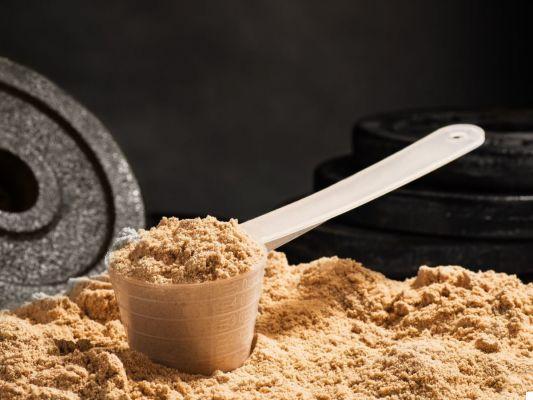
What
L'integration protein is a method of increase quantity di polypeptides food which is based on the consumption of:
- Supplements food - usually in powder form, obtained from various products such as egg, milk, soy, some cereals, legumes, etc;
- Food dietary fortified - such as yoghurt, smoothie, meal replacement, shake etc.
What is it for
Protein supplementation is intended for those who show a increased needs, or to whom DON'T fails to raggiungere la normal quota of protein with the diet ordinary (eating disorders, vegans, etc.). The need can increase for various reasons, physiological, paraphysiological or pathological. Some are:
- Intense sport e extended, mostly of strength or bodybuilding;
- Third Age and tendency to sarcopenia;
- Unrest related to digestion and absorption;
- Combination of multiple factors, such as unbalanced diet and gestation o nursing o Develop etc;
Note: it is important to underline that the goal of protein supplementation would be to increase above all the supply of amino acids essential.
For further information: Proteins
Protein requirement
Il protein requirement is determined by a number of factors including obligatory losses di nitrogen quality of the protein taken, L 'intake contemporary caloric, the physiological state el 'physical activity performed.
For those who train it is a lot difficult, if not impossible, guess the protein requirement necessary, as each of us has a different physical and metabolic structure. It must be said that this value is not always so different between individuals who practice the same activity and who have a similar conformation. However, this question of variability underlies the collective tendency to overdo the protein intake. Greater awareness would allow only the necessary proteins to be introduced.
For a sportsman, even of strength, it is totally useless to exceed an assumption equal to 1,4-2,4 g / kg di weight corporeal real. We also remember that proteins bring 4 kcal per gram and that excessive intake leads to a greater fat deposit by converting amino acids into fatty acids.
For further information: Breakdown of Proteins: When to Take Them?
Which Proteins
By a'integration which also takes into account the biological value, protein powders can be classified as follows:
- Protein from the siero some milk (high biological value - BV = 100): obtained for ultrafiltrazione, with about 6% fat and 80% protein; for microfiltration with values obtained of over 80% protein and 1% fat; for ion exchange, the best in quality as they represent 90% protein and less than 1% fat;
- Latte caseine (VB lower than the previous one, about 80): a lot sazianti, as they absorb water and are slower to digest;
- Protein Total of XNUMX cups milk (VB 100): they have an average digestibility on the whole;
- Proteinegg (VB 100);
- Proteins of the soy (VB less than 75);
- Proteins of others vegetable (medium or low VB, they do not have all the essential amino acids or present them in scarce quantities). It would be better to combine them with those of wheat or rice;
- Proteine del wheat and rice (with an abundance of gluten, VB of about 50, therefore low).
The proteins of animal origin are to be considered the best.
Why use supplements and not just food?
It is also good to point out that whoever chooses to cover up il just requirements protein taking alone Protein foods without supplement must also bear in mind that the VB mentioned above are calculated from proteins natural, not cooked. The cooking decreases the biological value - even if on the other hand it increases the digestibility of food.
To learn more: Are proteins bad for you?

























